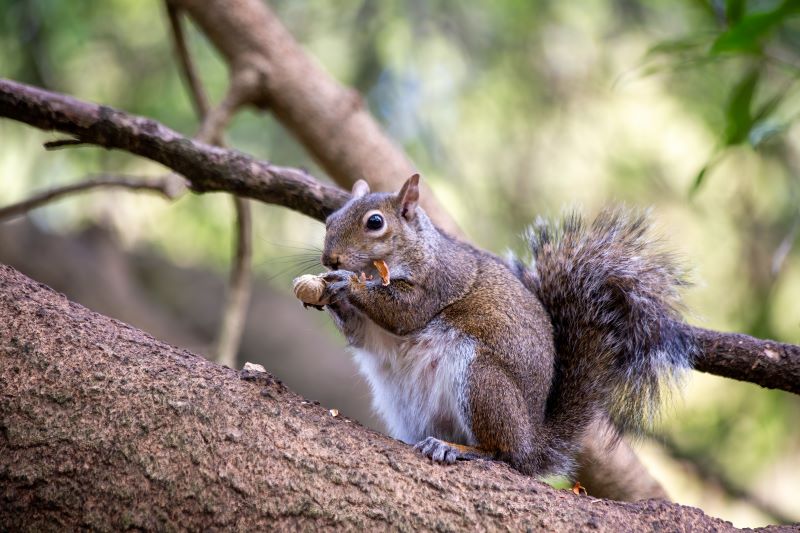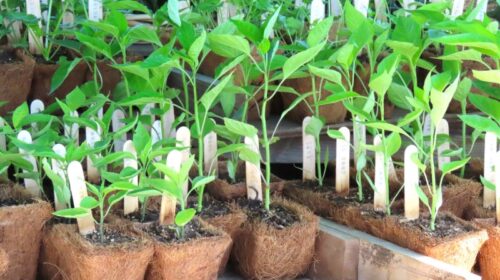Integrated Pest Management for Tree Squirrels
By Josh Reilly
Tree squirrels seem most active at this time of year. Running along perilously lofty, narrow power lines and fence tops, cheeks puffed out with food. Balancing and bobbing on thin branches, chattering noisily when passing house cats skulk below and hawks glide above, leaping across yawning gulfs of air, in seeming defiance of the laws of physics, they are impossibly energetic, irritable, and hungry. And charming freeloaders. If you have grapes, apples, apricots, plums, cherries, almonds, or walnuts, you have probably been sharing your crop with them. Squirrels will also eat strawberries, tomatoes, corn, and other crops. When not depriving you of salad and dessert, they dig up the garden, burying nuts, acorns, or other seeds (called “caching”). Oddly, they’ll dig up your daffodils, crocuses, and other bulbs, not to eat them, just to rebury them elsewhere in the yard, usually at the wrong depth or in the wrong spot, thus preventing proper growth and flowering. In March, my yard is full of underdeveloped daffodil shoots, popping up, nowhere near where I planted them, and failing to produce a single flower shoot.
Yet they are handsome animals and personable in their own way, foraging, defying predators, gravity, and death itself, to put away enough to feed the kids. We can relate. Up to a point. A great source of information is the University of California Integrated Pest Management Program. UCIPM pulls together science and practical experience to develop pest management protocols for just about every farm and garden varmint in the state. ipm.ucanr.edu/home-and-landscape/tree-squirrels/pest-notes
Be advised that tree squirrels have endless patience and enough cognitive resources to work around practically any control method. There are a few methods worth discussing, but be flexible and consistent in their application. Banding your fruit trees with 2-foot-wide sheet metal will prevent them from easily climbing up the trunk. Placing the band a foot off the ground may be enough to discourage them. Just be aware that tree squirrels can jump a long way. In my yard, a tree squirrel tried to run up a sheet metal band on my apple tree three times in a row, without success. The fourth time, it got a long running start, jumping and landing high enough to dig in and climb. Banding with a sticky barrier like Tree Tanglefoot may also help, as these animals prefer not to get stuck to the trunk. The product will partially dry, rendering it less effective, so re-apply at least annually. Tanglefoot may help with certain insect pests as well. It may be, however, that hungry squirrels will just endure sticky feet if they must to get your apples. Neither of these things works well if your tree is near a fence, roof, or other tree, from which they may jump or climb into the one you are trying to protect. Our local wine growers often use netting to keep squirrels and bluejays out of the grapes. If the vine is properly and thoroughly netted this can be effective, if not particularly easy or inexpensive.
Live traps are available, but use is prohibited here because neither the County nor the State want you to release trapped squirrels anywhere in our County. Add to that the danger of infection with tularemia if the live squirrel bites you. More information is available at the CA Dept of Fish and Wildlife: wildlife.ca.gov
Josh Reilly, aka Uncle Skip, writes about seasonal gardening from his home in beautiful Ben Lomond, California.
Featured photo by Dan Hadar: California Tree Squirrel
***
Have a news item to contribute? The San Lorenzo Valley Post welcomes your Santa Cruz Mountains news, story ideas, photos, and letters. Send us an email.
Sign up for our newsletter to stay connected to news and events in the Santa Cruz Mountains.




